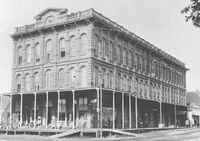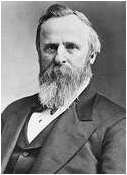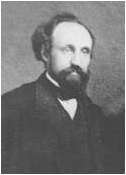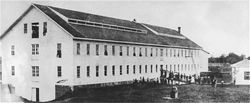Our History
The History of Reed Opera House
The Reed Opera House was designed from the start for more than the single purpose its name suggests. In fact, it wasn’t going to be an opera house at all.
New hampshire-born Cyrus Adams Reed (1825-1910), who built the Opera House in 1869-70, had a contract with the state to erect a building to house the Oregon State Legislature, the State Supreme Court and the State Library.
When the newly elected officers of a changing administration refused to comply with the agreement, Reed had Architect G.W. Rhodes include seven shops on the ground floor; the Opera House proper enjoyed the center of the building, on the second and third floors, and the balance of the building became the Reed Opera House Hotel.
The decision to build a 1,500 seat theater was an adventurous one. The population of Salem in 1870 was reported to be 1,139, being served by 11 grocery stores, 15 dry goods stores, three bars and three drug stores. Liberty Street was unpaved and rutted, and fist fights and gambling were nightly events.
Bell’s telephone would not be patented until 1876; Edison did not invent the light bulb until 1879, Chief Joseph was still battling U.S. forces in Oregon, and New York’s Metropolitan Opera House wouldn’t be built until 1883!
The pioneering Reed was not only an optimistic visionary, but a teacher, merchant, builder, industrialist, politician and artist who painted the opera house sets.
Reed’s Opera House became the center of Salem’s early social life, housing touring plays and opera companies, concerts by John Philip Sousa‘s band, vaudeville and minstrel shows, revival meetings, and exhibits by political cartoonist Thomas Nast, and other famous artists.
It was the favorite venue for Hallie Parrish Hinges, a singer who performed a concert at the Reed for President Benjamin Harrison on May 5, 1891, and was called “Oregon’s Nightingale” by Theodore Roosevelt a few years later.
The Reed’s stage was a pulpit for Susan B. Anthony and Abigail Scott Duniway at the height of the national drive for women’s suffrage, which in 1871 Oregon was headed by Cyrus Reed.
Another U.S. President – Rutherford B. Hayes – drew crowds to the Reed on September 30, 1880, while seeking to become more than a one-term leader.
The official opening of the Reed Opera House was Sept. 27, 1870, with the Inaugural Ball for Oregon Governor LaFayette Grover. Subsequent inaugurations for Republican Governors W. W.Thayer (1878), Z. F. Moody (1892), William Paine Lord (1895), and T. T. Geer (1899) were also celebrated at the Reed.
In addition to serving as Oregon’s Adjutant General from 1862-1870, Gen. Reed was head of Oregon’s Republican Party, served four terms in the state legislature (1862-1878), and was a founding director of Willamette Woolen Mills.
The first performance on the Reed stage was “Frances Carroll”, a drama depicting theater life. The Oregon Statesman commented in it’s Sept. 28, 1870 edition that “after a long time without any amusement except the legislature our citizens must, by this time, be in good trim to attend a first-class theatrical performance.”
The Reed would be Salem’s premier theater for the next 30 years, finally closing with a minstrel show on April 26, 1900, shortly after the opening of the new Grand Theater a block away.
E. P. McCornack, who purchased Gen. Reed’s interest in the Opera House in 1885, converted the theater and the balance of the retail space into Salem’s first major department store, Joseph Meyers & Sons. In 1902, McCornack added a two-story building immediately south of the Reed, at 177 Liberty Street, to house a furniture store.
In 1920 the Miller’s Department Store purchased and occupied both buildings, and dominated Salem’s retail scene until the mid-1970s.
In 1976, the Reed and the Montgomery Ward Building, erected next to the McCornack addition at 155 Liberty in 1936, were acquired by Realtor Coburn Grabenhorst St. and Architects Phil Settecase and Howard Smith, who converted the buildings into their present configuration for an estimated $1 million. Settecase would soon have a major impact on Salem architecture. In addition to the Reed interior, he designed the Salem Civic Center, Salem Public Library, Downtown Fire Station and 17 buildings on the Willamette University campus.
The newly redeveloped Reed – with retail boutiques and restaurants on the lower level, first floor, mezzanine and second floor – prospered until the 500,000 square foot Salem Center opened in the late 1980s. The Montgomery Ward building was sold off, and the owners eventually opted to turn the deed to the Reed and the McCormack addition over to the bank that financed the redevelopment.
In March 2003 Roger Yost, a former Jantzen Swim Wear marketing vice president and garden center developer, purchased the Reed Opera House from Bourne Properties, which had acquired the building 10 years earlier. Yost worked to significantly remodel areas of the Reed, including architecture, ballroom upgrades and elevator work.
In 2018, Yost sold the Reed to Cumberland Holdings, a West Coast real estate investment firm. Cumberland’s vision is to restore the Reed to its former glory and make it the crown jewel of Salem once again. Their plan includes significant renovations to the exterior and internal common areas with new shops , restaurants, services and community amenities.
Most recently, the Reed Ballroom and kitchen has been remodelled to make the large, dynamic event space even more appealing. They also completed a seismic repointing to ensure that the historic brickwork would be more structurally sound in case of an earthquake. The future for the Reed is bright!
Cyrus Reed, 1825-1910
Oregon’s ‘Renaissance Man’
Cyrus Adams Reed, builder of “Reed‘s” Opera House in 1870, and remembered as one of Oregon’s first ‘renaissance men’, may have lived a comfortable life as a New England carriage maker were it not for the lure of the California gold fields.
Orphaned as a boy, apprenticed at 14 to a carriage maker where he acquired painting skills, the young Reed nonetheless was graduated from Union Academy in his native Grafton, NH , and began his professional life as a school teacher.
He taught for five years, then briefly re-entered the carriage trade before leaving for California February 2, 1849 with close friend William Abrams, an accomplished millwright, via Panama across the Isthmus, where they spent three months waiting for a ship to take them to Monterey. The 24-year-old Reed arrived in September, 1849, and made his way north to the mining regions, where he stayed less than two months.
After relocating to San Francisco as a sign painter, Reed teamed up with an old yankee friend, William Abrams. The two would once again be persuaded by early Portland developer Stephen Coffin to bring their skills and futures to Portland, then an almost unbroken forest inhabited by 250 white settlers and about 1000 Native Americans.
They arrived in Portland on New Year’s Day, 1850, after a perilous crossing of the Astoria bar, and almost immediately began contributing to their new state’s history.
Abrams and Reed would help Coffin build the city’s first sawmill.
Although William Abrams was the millwright, it was Cyrus Reed who “saved the day” when it came to building the sawmill.
The mill was to be constructed with 16-inch square timber beams, which were too heavy for Coffin’s Portland building crew to lift. Coffin set off for Oregon City with a flat boat in search of help, but even an additional complement of men could not raise the timbers.
Faced with the painful prospect of having a mill too big to be put together by all of the available men in Oregon, Reed offered to build a derrick, agreeing to forfeit $100 in wages if he failed. With the derrick, blocks and tackle, he enabled the men present to lift every timber into place.
Reed would raise $1000 from local citizens to buy books from Harper & Co. to establish Portland’s first library, agree to become the city’s first librarian, and teach its second school term.
While engaged as a teacher, Reed also kept books for Coffin’s general merchandise store, and platted most of Portland’s streets and deeds of conveyance of city lots for Coffin, one of three principal owners of the developing city’s land.
On July 7, 1850, Reed married Coffin’s daughter, Lucinda, one of Reed’s students, not yet 15, while Coffin was in the East on business. Mrs. Coffin reportedly was so upset by the union, she would not speak to her daughter or Cyrus Reed until the Reeds’ first of seven children was born a year later.
By 1852, Reed, now 27, had acquired a one-fifth interest in the Abrams-Coffin sawmill, plus several blocks and scattered lots in Portland, most of which were sold when he purchased a 640-acre farm in Salem that year.
Two years later, Reed became one of Salem’s first druggists; established a mercantile store, and was elected treasurer of the Marion County Agricultural Society. He would also participate in meetings to establish the first “Territorial Fair,” forerunner to the current Oregon State Fair.
In 1855 Reed’s sister, Anna, would migrate from New Hampshire to Salem, eventually marry George Jones, who joined Cyrus Reed and another partner in 1856 to establish Jones, Reed & Co., the first door, sash, blind and labor-saving manufactory in Oregon.
A year later, Reed, 32, would be among the founding directors and one of the builders of Willamette Woolen Mills , which would become Salem’s leading manufacturer and largest employer (100 workers), until fire destroyed the facility May 3, 1875.
In 1862, at 37, Reed was elected to the first of four 4-year terms to the Oregon State Legislature; framed the state’s militia law, and was appointed Oregon’s Civil War Adjutant General by Governor A.C. Gibbs.
The growth of Oregon’s state government and the prospects of forming a state supreme court resulted in legislators urging General Reed to create a complex that would house state offices, the legislature, the supreme court and the court library.
When a changing administration reneged on an agreement to create such a building, Gen. Reed had architect G.W. Rhodes design a structure with ground-floor retail, an opera house that shared the second and third floors, and hotel rooms where the state offices would have been.
The structure, made from 1,000,000 bricks, cost $75,000 to build, and opened on September 27, 1870 to celebrate the inauguration of Gov. LaFayette Grover, who would later play a pivotal role in the 1876 presidential race between Rutherford B. Hayes and Samuel Tilden.
Reed’s Opera House, the center of Salem’s early social life for more than thirty years, hosted major political celebrations, traveling theatrical and minstrel shows, musicals, concerts, and fund-raising events featuring Thomas Nast and Samuel Clemens (both of who performed to pay off debts).
Gen. Reed, who painted many of the sets for the theater, was a founder of Oregon’s Republican party; first president of Oregon’s Women’s Suffrage Association, and brought Susan B. Anthony and Abigail Scott Duniway to the Opera House stage to campaign for woman’s suffrage in 1871. (He also was the only male to appear on stage with Ms. Anthony during her Portland campaign appearances.)
Shortly after the Opera House was opened, the expenses incurred during construction took their toll on Gen. Reed, and he was forced to return to painting and open an insurance and real estate office to help retire debts.
In 1873, Gen. Reed created panoramas depicting his beloved Oregon. The art was exhibited in Philadelphia and Europe. Proceeds from the fine art and real estate enabled the general to repay creditors and regain control of his landmark.
At about the same time, Gen. Reed’s marriage to Lucinda ended. In 1875, he married 20-year-old Jennie Cline, a co-worker and native Oregonian, with whom he fathered an additional six children.
In 1885, Gen. Reed sold the Opera House to E.P. McCornack, and moved his family to Portland.
In 1890, at age 65, Gen. Reed, still ‘politically connected’, was appointed government agent of the manufacturies; deputy census enumerator, and inspector of the mortgaged and encumbered homes of Multnomah County.
He lived his final days in the International Order of Oddfellows home in Portland before passing away at 85 on July 9, 1910. His remains are interred in the Riverview Cemetery, next to three of his sons and the sons’ widows.




